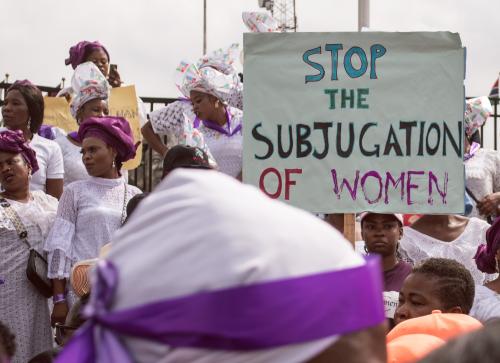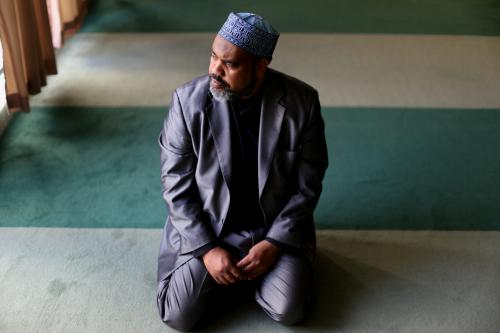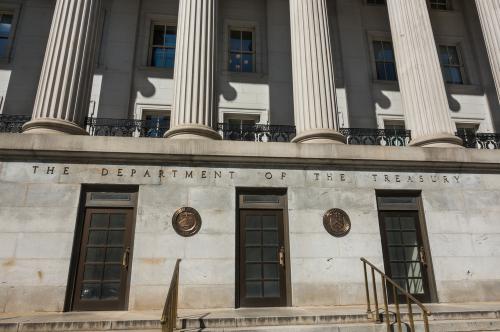The Middle East and North Africa (MENA) is the most patriarchal region in the world. Although there is great variety in the region—Beirut and Istanbul are more liberal than Cairo and Qom—every single country in MENA has lower female employment and political leadership than the global average.
Figure 1. Gender inequalities in MENA and other developing regions, 2000
Source: Nabli and Chamlou 2004
Why is MENA such an outlier?
- Unaffordable childcare? Private care is expensive and public funding is meager. But even among Turkish women who are childless, employment remains low.
- Oil wealth? Even if there is a giant oil discovery in a highly Muslim country, female labor force participation only falls by two percentage points over 10 years.
- Western imperialism? Development generally leads to female emancipation, and imperialism has inhibited development and democratization in the Global South. But female seclusion in MENA was the norm long before colonialism and remains far more pervasive in the region than in other countries with similar wealth.
- Desert geography? Pastoralism is associated with honor cultures and female seclusion, but there is still huge unexplained variation. Most Arabs have been farmers. In this very same geography, Ancient Egyptian women once socialized freely, with scant concern for virginity, and commanded respect as priestesses to female goddesses.
So what happened?
A diverse region became gender-segregated
Before Islam, gender relations were diverse across MENA. Southern Mesopotamia was certainly patriarchal: female seclusion marked respectability. Veiling was mandatory for high-status Assyrian women, but explicitly prohibited for slaves and prostitutes. Under Zoroastrianism over a third of religious sins concerned female sexuality. But in Ancient Egypt, women had equal rights under the law. Queen Zenobia (of what is now Syria) led 70,000 men into battle against the Roman Empire. The Amazigh (Berber) revered women leaders: goddess Tanit, warrior queen Tin Hinan, and military commander Dihya.
After the Arab-Islamic conquests, female seclusion became increasingly normative across the entire MENA region. This is due to three institutional innovations carried by Islam, originating in pre-Islamic Arabian and Mesopotamian influences: patrilineal tribalism, religious authoritarianism, and gender segregation as expressions of piety.
Figure 2. Islamic conquests in the 7th-9th centuries
Source: World History Publishing. CC BY-NC-SA 3.0.
Islamization entailed Arabization: Adoption of customs from the Arabian peninsula that predated Islam but may have been baked into the religion at its birth. Conquered peoples only gradually converted to Islam and adopted the Arabic language. As part of this cultural assimilation, they also adopted tribes and cousin marriage. To this day, cousin marriage remains especially high in Muslim-majority countries that were originally part of the Umayyad Caliphate.
Close-knit, patrilineal kinship was cemented by Sharia law, which recognizes succession through the male line, male agnates’ inheritance, paternal ownership of children, and easy divorce for men. Paradoxically, patrilineal kinship was also reinforced by the Islamic stipulation of female inheritance rights. Kin marriage kept wealth in the family, while also consolidating fraternal solidarity and shared honor.
Islamic ethics was strongly influenced by Persian theologians who managed state institutions of learning when Iraq was the seat of the Sunni Muslim empire. Transmitting Mesopotamian and Zoroastrian influences to Islam, these clerics conceived of men as intellectually superior and rightful patriarchs who achieved ethical perfection by cloistering their wives. They repeatedly barred women from communal prayers in the mosque. Though 12th century Damascan and Cairenese women sometimes defied these prescriptions (occasionally they even preached), piety increasingly came to require gender segregation.
The pre-Islamic custom of veiling and secluding women to mark status was given a new life by slavery in the Islamic period. As Islam banned the enslavement of Muslims, there was an expansion of the slave trade from outside the empire. Women veiled to differentiate themselves from slaves. Female slaves also displaced Muslim women as domestic workers.
As a result of both Islamization and Arabization, male honor became contingent on the propriety of female kin. The economic advantages of female wage labor were outweighed by the inevitable suspicion, stigma, and social ostracism. Muslim patrilineal clans thus preferred to maintain prestige and purity through female seclusion. Even when factories were established in Ottoman towns, MENA women remained in home-based production, weaving carpets under the eyes of male kin. Few families wanted to stick their neck out and be the first to send their daughter away, because she might be perceived as promiscuous. The unwillingness of families to deviate from this norm unilaterally created a negative feedback loop in which wage labor remained exceptional for women. I call this “The Patrilineal Trap”.
Open debates were suppressed by religious authoritarianism. Military rulers maintained legitimacy by rewarding loyal clerics with waqf income, funding mosques, and madrasas. This alliance between state and clergy inhibited independent critique, thus many families continued to be locked in a culture of deference to clerics, who reinforced female seclusion with warnings of divine punishment.
Modern debates about Islam
Confrontation with European modernity provoked elite debates about women’s place in society. As men became more educated, they increasingly valued female education (to create good wives and mothers). Although clerics denounced girls’ schools as un-Islamic, feminists fought back. Publishing journals, women debunked men’s narratives, decried their “imprisonment” and highlighted scriptural support for equality.
Ambitious leaders in MENA sought to catch up with Europe and embarked on top-down economic modernization and societal transformation. They nationalized religious institutions. Turkish President Kemal Atatürk’s 1926 law recognized women as equal citizens, with equal entitlement to inherit and act as witnesses in court. But state-led control and the suppression of independent associations meant that ideological changes did not reach the masses, who remained deferential to religious authorities. Liberalism was confined to a small elite, with little independent critique of traditional ideologies in the wider society.
“Modernization”, however, became discredited by economic stagnation and the inability to defeat Israel. In Egypt, clerics equated modernity with a rejection of Islam and declared the economic and military failures of the state to be punishments for aping the West. Islamic preachers called on men to restore order and piety (i.e., female seclusion). Frustrated graduates, struggling to find white collar work, found solace in religion, whilst many ordinary people turned to the Muslim Brotherhood for social services and righteous purpose.
The Iranian Revolution inspired hope in the possibility of political Islam. Quranic reading groups, publishing houses, cassette tapes, missionaries, and mosques proliferated across MENA—financed partly by Saudi Arabia.
In Turkey, however, the Islamic revival was strengthened by rapid economic development. Economic liberalization enriched and empowered a flourishing independent, socially conservative bourgeoisie, which funded its own religious media and schools. As the AKP triumphed in elections, it quadrupled state spending on religion.
Has the Islamic revival slowed progress towards gender equality?
Yes. Political elites who might otherwise be open to reform are intimidated by potential backlash from clerics. MENA states seek legitimacy by appealing to Islam. Restrictions on Islamist parties were loosened; and there was more funding for mosque construction, religious media, and religious schools. Male guardianship laws remain in place.
In an environment of mass religious revival, preachers lambast women for defying God’s law, and those voting for Islamist parties are much less concerned about gender equality. As a result, zealots are free to harass women with impunity. In Algeria, Islamists instilled fear by killing female teachers and raping journalists. When Moroccan feminists petitioned for reform, they were harassed and condemned as anti-Islamic, Western stooges. Repression likewise persists in Iran through morality squads and state-controlled media. Gangs of male youths police Cairo’s streets as they leer, lecture, and snitch on women. And so many women who otherwise might not veil, end up veiling to avoid harassment, or retreat entirely from public view
As liberals self-censor to avoid aggression by religious radicals, patriarchal beliefs go unchallenged in public, and pessimism about change is reinforced by the invisibility of potential allies. Never hearing dissent, some Iranian women still believe that refusing conjugal sex is sinful.
The Patrilineal Trap is reinforced by the structure of MENA economies
MENA economies are segmented into insiders and outsiders. Insiders benefit from state protection, contracts, subsidies, licenses, and land. Outsiders remain trapped in precarious employment. Economically, this retards private sector job creation, and small firms struggle to grow and remain largely family-based.
Arabs continue to rely on wasta. Social connections are necessary to access jobs, secure permits, avoid trickery, and resolve conflicts. Even middle-class, professional Jordanians acquire social insurance from kin. Loyalty is also culturally esteemed: Girls are encouraged to put family first, above narrow self-interest.
Membership in such networks is contingent upon maintaining family honor, which is easily damaged by rumors of female impropriety. Fear of expulsion from wasta networks motivates families to police women.
“I love my mother but…[s]he worried so much about our reputation and always warned us about this or that… It seems that all she had to teach us was how to protect family honor (Bahira, Iraqi).
MENA families remain caught in the Patrilineal Trap. Female wages are still too low to compensate for the loss of male honor. So women remain at home, with little autonomy or social networking. Men, however, are free to forge new connections, run family firms, gain knowledge of the wider world, and become trusted authorities. Unlike every other world region, young men in North Africa are no more egalitarian than their grandfathers. Nearly all see men as superior political leaders. Although pious women have been integral to Islamists’ outreach, leadership remains male dominated and patriarchal.
Sexual harassment of women is rampant in MENA cities. In Cairo, men lecher at women with impunity. They make sexually explicit remarks, grab, grope, and stalk strangers in the streets. Young women feel anxious, ashamed, and petrified about what onlookers might say because victims are typically blamed for the actions of men. The presumption that women must have invited sexual aggression through indecent dressing or other behaviors fuels the vicious cycle in which male relatives fear the loss of honor, and prefer to seclude women. For this reason, Turkish men do not want their wives to traverse the country as traders or work behind closed doors for unrelated kin.
The Patrilineal Trap is not Insurmountable!
Female employment does rise if economic returns to women working outweigh the loss of family honor. Examples are abundant from Turkey which has grown most rapidly in MENA, to thriving labor-intensive industries in the Maghreb and the consequences of Kuwait’s labor nationalization. Public sector employment is popular with MENA women because it is safe and respectable.
When women do seize paid work in the public sphere, they gain self-esteem and socialize more broadly. Gathering in cafes and forging new friendships, they collectively lambast unfairness.
Feminists have campaigned for greater rights, autonomy, and protection. The Turkish women’s movement has campaigned against harassment, male violence, and virginity tests. In Morocco and Tunisia, activists have successfully challenged Islamist parties and cemented their rights. Just last year, Egyptian women forced a U-turn on regressive legislation. The Muslim Sisterhood has publicly challenged ideologies of “shame”. Guerrillas in Rojava are dismantling ideologies of male dominance, with gender quotas. Saudi women are publishing novels, sharing their ideas with the world. Eschewing patriarchal clergy, Iranian women have gathered to interpret scripture for themselves, published magazines, and petitioned the government. Feminist readings of the Quran are amplified by Musawah, a global movement for equality in the Muslim family. Arabic Palestinian rappers have decried honor killings in their viral music video.
? image of #feminist protestors in #Turkey against a library guard who scolded a woman for wearing shorts. The sign: "Don't interfere with my shorts, my headscarf." #democracy https://t.co/PO6CmaNCm9 pic.twitter.com/uf6M9uUS44
— Merve Tahiroglu (@MerveTahiroglu) June 12, 2020
But MENA feminists face an uphill battle as they continue to be restricted by patrilineal kin, molested in male-dominated streets, condemned by Islamists, and repressed by authoritarians. When Abdel Fattah el-Sisi
cracked down on civil society, Egyptian women curtailed their campaign against sexual harassment. As Moroccan feminist Bouchra Abdou shared, “I feel like we are in the bottom of a well. We keep screaming but no one hears us.”
In sum, a once heterogeneous region (sometimes ruled by women) became and has remained extremely patriarchal thanks to the Arab-Islamic conquests and Shariah law, which have cemented patrilineal kinship and religious authoritarianism.
The Brookings Institution is committed to quality, independence, and impact.
We are supported by a diverse array of funders. In line with our values and policies, each Brookings publication represents the sole views of its author(s).








Commentary
The Middle East and North Africa’s patrilineal trap
January 25, 2022